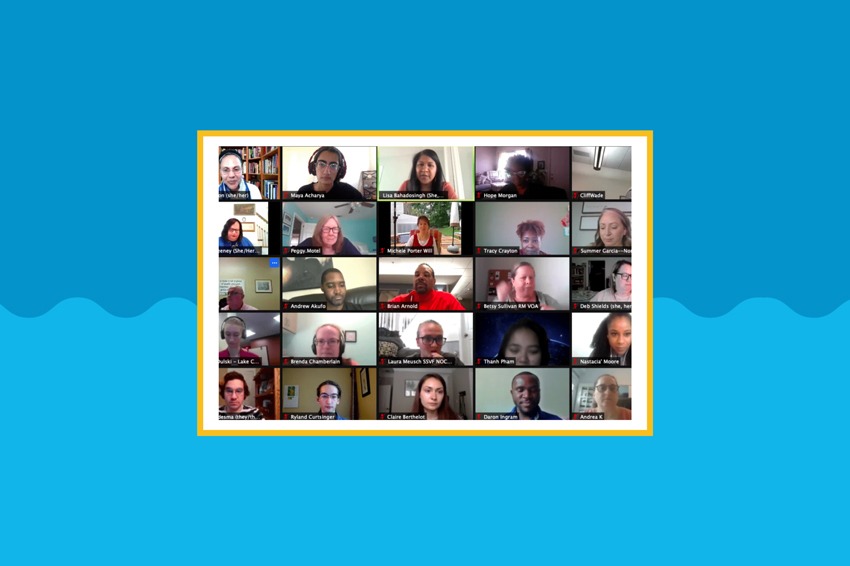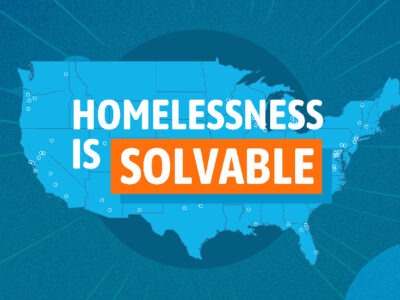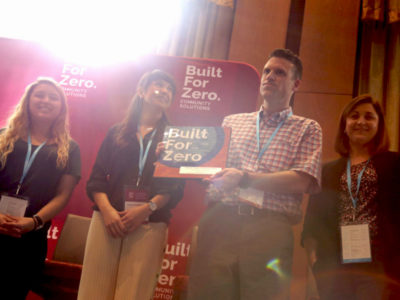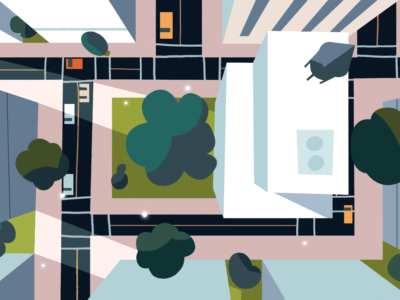Against the backdrop of a year filled with loss, challenges, and a reckoning with the inequality across all of our systems, leaders from 87 Built for Zero cities and counties virtually convened at the virtual Spring Learning Session. The communities celebrated progress and learned together as a movement to end homelessness. They gathered to focus on ending homelessness for single adults, building on the foundation for racial equity work, and launching a new cohort model.
“We want you to feel unstoppable. We want you to feel that functional zero is inevitable, like you can achieve and sustain your goals in the face of new challenges and transformation,” said Garen Nigon, Built for Zero Strategy Lead.
Celebrating progress toward functional zero
In the past 7 months:
- 6 communities achieved quality data:
- Anchorage CoC
- Nassau / Suffolk Counties CoC
- St. Johns County CoC
- Virginia BOS – Crater Area Coalition on Homelessness
- Mid-Willamette Valley Homeless Alliance
- Western Virginia CoC
- 8 communities drove a reduction in homelessness:
- Charlotte-Mecklenburg CoC
- Charlottesville CoC
- Colorado BOS – Fremont
- Columbia-Boone County/Missouri Balance of State CoC
- Gulf Coast of Mississippi
- Jacksonville/Duval/Clay Counties
- Lake County/North Chicago
- Phoenix/Mesa/Maricopa County Regional CoC
- 7 new communities joined Built for Zero:
- Colorado Balance of State – Southwest Region
- Colorado Balance of State – Western Colorado
- Downtown Cincinnati Continuum of Care
- Kent County
- Sonoma County Continuum of Care
- Texas Balance of State – Lubbock
- Wayne Metropolitan Community Action Agency
Built for Zero communities celebrated progress across all points of the collective journey to create data-driven systems of support that ensure no one gets trapped in the cycle of homelessness.
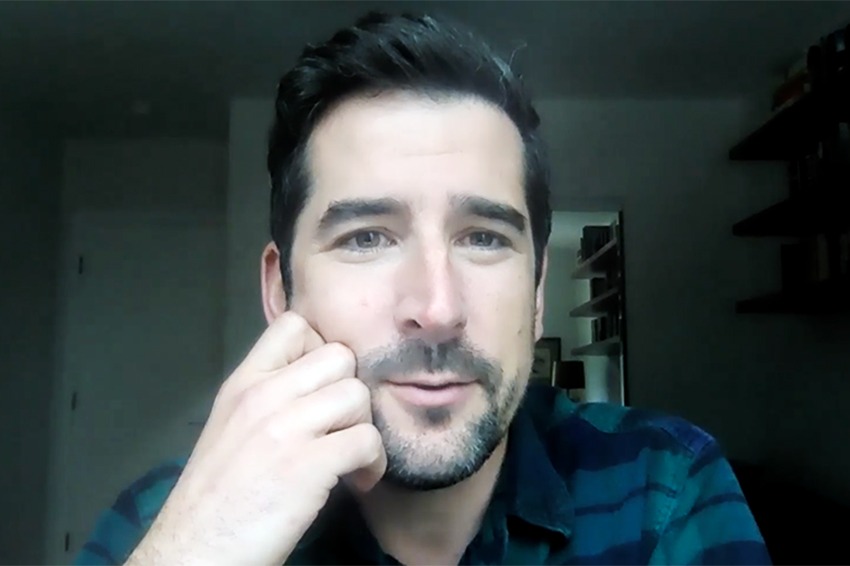
“This is a movement built not on good ideas, but on evidence. You all have demonstrated that it is possible to get all the way to zero in a community. You haven’t just demonstrated it once. You’ve demonstrated it over and over and over.”
— Jake Maguire, Built for Zero Co-Director and plenary speaker
Ending Homelessness for Single Adults
Communities in Built for Zero have proven it is possible to reach functional zero for chronic and veteran homelessness. The team is leaning into ensuring communities have the support they need to help communities end homelessness for all single adults.
“The goal today is to go from blueprints and then pivot into how we would operationalize these in the field,” said Aras Jizan, Portfolio Lead for Data and Technology in Built for Zero.
Built for Zero communities work to create a system that ends homelessness one population at a time. Single adults are a population often living unsheltered, representing one of the most visible manifestations of homelessness.
“This population allows us to make visible change and really increase the believability that this is possible. We can create a road map for other communities, and change what is possible and expected at the national level,” said Beth Sandor, co-director of Built for Zero.
Communities were joined by Richard Cho, Senior Advisor for Housing and Services at the U.S. Department of Housing and Urban Development. Cho discussed the unprecedented amount of federal aid coming into communities for housing and homelessness, as well as the urgency needed to scale up the work to equitably end homelessness for veteran and chronic populations to single adults.
“Let’s apply to all — we’ve proven that we can house anyone, now our job is to house everyone.” – @Richard_S_Cho on ending homelessness, one population at a time, with a focus on single adults experiencing homelessness. #BFZLearning https://t.co/LwlUZsTidF pic.twitter.com/ZCr61LAWuL
— Built for Zero (@BuiltforZero) May 19, 2021
Communities currently working on ending homelessness for single adults offered learnings from their work on the ground.
“There are a lot more similarities between the work for single adults and the work for veteran and chronic populations than differences. We see the same kind of challenges: how do we keep people housed?“ said Abby Dunner of the Fairfax County Government and community lead in Fairfax, Virginia.
Building on the foundation of racial equity
In the coming months, communities will focus on achieving quality data that includes information on race and ethnicity, with the aim of making racial equity in systems outcomes a standard part of monthly data reporting. Following the last Learning Session’s introduction to the racial equity framework, communities participated in sessions with C4 Innovations and data experts from the Built for Zero team to build on the framework of racial equity.
“When we don’t acknowledge and identify the privilege and power that comes with whiteness, then we keep ourselves open to keeping on racial trauma and (micro) aggressions,” said Regina Cannon, Chief Equity and Impact Officer at C4 Innovations.
Communities learned how to build the foundation to equitably end homelessness, including by acknowledging personal biases and the structural racism embedded in our society, striving for equity over equality, and interrupting racist systems to say: this is not working for everyone.
A racially equitable homeless response system also requires quality data to ensure that housing outcomes are not producing racial disparities. Communities do not typically have access to real-time data on everyone experiencing homelessness by race, so building this data is a necessary first step to ensuring housing equity.
“We want to improve system outcomes through the lens of racial equity,” said Jizan.
Launching New Cohorts
The Learning Session marked the launch of new cohorts that the Built for Zero movement is testing to help communities accelerate progress. Each cohort is intended to help communities learn faster by matching them with peer communities and coaches that can support the unique needs of that community, whether that is related to its focus population, the complexity or density of the challenge in its context, or its improvement goals. The specialized team of coaches for each cohort will follow a curriculum by designing changes, testing them, and tracking results.
The cohorts will now include:
- Improvement System Shaper Cohort: Communities will work toward being certified for a quality by-name list and achieving its first by-name list reduction.
- Shift Lab Cohort: Communities will work toward achieving its first or next shift, and building improvement habits that will take them to functional zero.
- System Flow Cohort: Communities will work to reduce the length of time from identification to housing.
- Last Mile Cohort: Communities work toward ending homelessness for a target population within the next six months.
- Large City Cohort: Communities working to reach functional zero in large, complex cities with a high density of homelessness.
“It’s not just about your outcomes: it’s not my results, it’s our results. It’s our system change, our transformed coalition, our communities that ended homelessness. We’re going to get there together,” said Niñon Lewis, Vice President of the Institute for Healthcare Improvement.
Niñon Lewis describes six touchstones for unlocking the power of working in a collaborative cohort.
